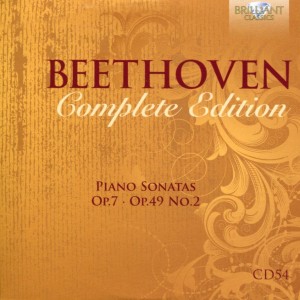 Once again, Alfred Brendel‘s masterful piano playing and Beethoven’s extraordinary gift for composing combine to create music that grabs me from the get-go.
Once again, Alfred Brendel‘s masterful piano playing and Beethoven’s extraordinary gift for composing combine to create music that grabs me from the get-go.
To me, Movement I (“Allegro molto e con brio”) of Piano Sonata No. 4 in E Flat Op. 7 sounds more like Boogie-Woogie Jazz or some kind of contemporary improvisational music than it does Classical music.
But then the stately Movement II (“Largo con gran espressione”) follows and I am reminded that I’m listening to Classical music from the late Classical period as it morphs into the Romantic period.
Here’s what I’ve been listening to today:
Piano Sonata No. 4 in E Flat Op. 7 (composed 1796-1797; Beethoven was 26-27 years old)
From its entry on Wikipedia:
Ludwig van Beethoven’s Piano Sonata No. 4, in E-flat major, Op. 7, sometimes nicknamed the Grand Sonata, dedicated to his student Babette Countess Keglevics, has four movements.
Piano Sonata No. 20 in G Op. 49 No. 2 (published 1805, possibly composed many years earlier; Beethoven was 35 upon publication)
From its entry on Wiki:
The Piano Sonata No. 19 in G minor, Op. 49, No. 1, and Piano Sonata No. 20 in G major, Op. 49, No. 2, are short (and are considered relatively simple sonatas by some pianists) by Ludwig van Beethoven, published in 1805 (although the works were likely composed several years earlier). Both works are approximately eight minutes in length, and are split into two movements. These sonatas are referred to as the Leichte Sonaten to be given to his friends and students.
The Piano Sonata No. 20 was possibly written around the time Beethoven composed the Third and Fourth sonatas, but because it was published in Vienna in 1805, nearly a decade after it was actually written, it was assigned then-current opus and sonata numbers, which classified it alongside works from the composer’s middle period. Very similar circumstances caused Beethoven’s B-flat Piano Concerto to appear as his second, even though it predated the first.
According to the back of the CD sleeve, these recordings were made in 1961-1966. They sound great for being over half a century old. A little tape hiss, sure. But the magical performances overshadow source tape limitations.
I wasn’t totally blown away by these pieces of music the way I was a few others. But this is a great CD if one wishes an introduction to Beethoven’s piano sonatas. There’s not a movement here that I don’t enjoy.
